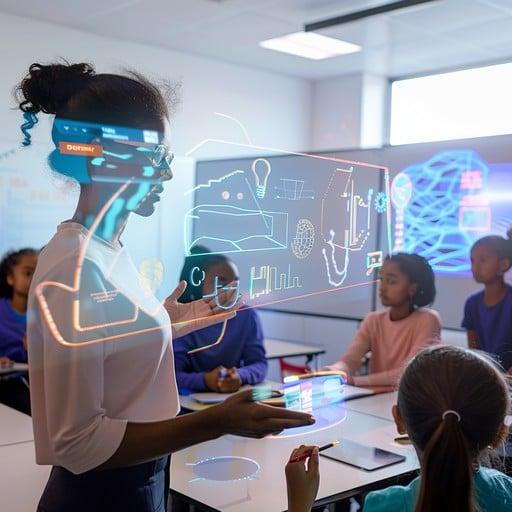Revolutionizing Education: How VR/AR Immersive Learning Is Shaping the Future of Classrooms
The rapid progression of technology in education has brought about a paradigm shift in how students interact with facts. Among the most impactful innovations are Virtual Reality (VR) and Augmented Reality (AR), which are transforming conventional classroom experiences into immersive learning environments.By bridging sensory engagement with cutting-edge digital content,VR/AR technologies are revolutionizing education and paving the way for classrooms of the future. This article explores the profound impact of VR and AR,their benefits,real-world applications,and practical tips for integrating these immersive tools for a richer educational journey.
Understanding VR/AR Immersive Learning
VR (Virtual Reality) immerses users in 360-degree digital worlds, typically using specialized headsets, while AR (Augmented Reality) overlays digital information on the real world through smartphones, tablets, or smart glasses.Both technologies allow learners to experience information in new,interactive ways,enhancing student engagement and knowledge retention.
- Virtual Reality Learning – Takes learners on virtual field trips, simulates complex scientific experiments, and recreates past events.
- Augmented Reality Learning – Adds interactive 3D models to textbooks,brings science diagrams to life,and assists with language learning through real-world cues.
The Benefits of VR/AR in Modern Classrooms
Implementing VR/AR in education is far from a technological gimmick; it’s a serious investment in the future of learning. Here’s why:
1. Increased Engagement and Motivation
- Immersive content turns passive learning into active exploration.
- Students are more likely to participate and stay focused.
2. Enhanced Retention and Understanding
- Visual and interactive learning aids boost memory.
- Complex concepts become simpler through visualization.
3. Safe Simulation and Experimentation
- VR simulations provide risk-free opportunities to practice skills, e.g., virtual dissection or chemistry experiments.
- Error-pleasant learning environments encourage experimentation.
4. Accessibility and Inclusivity
- VR/AR can accommodate students with different learning needs and styles.
- Remote learners can experience the same content as those in traditional classrooms.
5. Fostering Creativity and Critical Thinking
- Students can manipulate digital objects and scenarios, inspiring creative problem-solving.
- Role-playing in AR/VR simulations enhances empathy and decision-making skills.
Real-World Case Studies: VR/AR in Action
Numerous schools and universities worldwide are implementing VR/AR immersive learning with extraordinary results. Here are a few inspiring examples:
- Stanford University’s Virtual Human Interaction Lab (VHIL) uses VR to teach students about empathy and social issues, allowing them to experience different perspectives virtually.
- zspace in K-12 Classrooms provides AR-enabled laptops and software that let students interact with 3D models of the human heart, planets, and historical sites for an enhanced science and geography curriculum.
- Google Expeditions offers virtual field trips, taking students to ancient Rome, the Great Barrier Reef, or even inside the International Space Station, making global education accessible from any classroom.
- Universidad Panamericana, Mexico deploys AR to teach industrial design, allowing students to view and interact with digital prototypes in real-world spaces.
First-Hand Experiences: What Educators and Students Are Saying
Feedback from both teachers and learners affirms the transformative power of VR/AR immersive learning:
“After integrating VR science labs,students who struggled with abstract concepts became engaged and started asking more questions. The technology made them feel like scientists in real labs.”
— Ms. Rodriguez, Middle School Science Teacher
“History was always boring. But when I saw ancient Egypt in VR, it was like walking in a time machine.I’ll never forget it!”
— Jamie, High School Student
Practical Tips: Implementing VR/AR in Your Classroom
Ready to use immersive technologies in your teaching or school? Here’s how to get started:
- Start Small – Pilot a lesson or unit with free or low-cost VR/AR apps on existing tablets or smartphones.
- Choose Appropriate Content – Select VR/AR experiences relevant to your curriculum, ensuring they align with learning objectives.
- Plan for Accessibility – Make sure all students can participate, including those with physical or sensory disabilities.
- Facilitate Meaningful Discussions – Use immersive content as a springboard for discussion,analysis,or creative activities.
- Get Feedback – Ask students for input on what worked and what could be improved to refine future integrations.
- stay Updated – The VR/AR field evolves rapidly; subscribe to edtech newsletters or online communities for the latest resources.
The Future of Classrooms: What Lies Ahead?
As VR/AR technology matures—becoming more affordable and user-friendly—future classrooms will likely blend physical and digital worlds seamlessly. the prospect of personalized, student-driven learning journeys is closer than ever. With AI-driven analytics, teachers can tailor VR/AR experiences to each individual’s pace, strengths, and preferences.
Moreover, integration with the metaverse could open up global classrooms, where students collaborate across continents in shared virtual environments. The ultimate result? Lifelong learners equipped for the demands of a rapidly changing world.
Conclusion: VR/AR Immersive Learning as a Game-Changer
The evidence is clear—VR/AR immersive learning is shaping the future of classrooms, breaking free from the constraints of textbooks and traditional lectures. By embracing these technologies, educators empower students to unleash their potential through experiential, meaningful, and joyful learning.
As we continue to explore and adopt virtual and augmented reality in education, the classroom will become a launchpad for revelation, empathy, and innovation. The revolution in education is not coming—it’s already here. Are you ready to be a part of it?

